Items
Tag
Prints
-
 El Hambre En La Ciudad De Mexico, 1914-15 Woman and children watching two men standing over horse laying on ground.
El Hambre En La Ciudad De Mexico, 1914-15 Woman and children watching two men standing over horse laying on ground. -
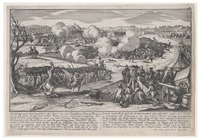 Battle of Saratoga (September 19, 1777) Print of the Battle of Saratoga.
Battle of Saratoga (September 19, 1777) Print of the Battle of Saratoga. -
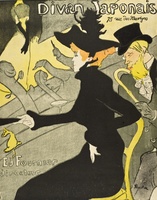 Divan Japonais "With over 200 prints from the so-called Belle Epoque, the Bremen Kunstverein’s collection of French posters is reckoned to be among the largest of its kind in Germany. This well-known poster by Henri de Toulouse-Lautrec was an advertisement for the Divan Japonais, a small café-concert hall in Montmartre decorated in the Japanese style. In the foreground is a silhouette of Jane Avril, a friend of the artist, famous for her wild and obscene dance performances. Her companion is Edouard Dujardin, the writer and founder of the Revue Wagneriénne. Above the outlines of the violin necks and the baton of the conductor in the orchestra pit, Toulouse-Lautrec allows us a glimpse of the stage, where the chanson singer Yvette Guilbert is performing. Since by this time Guilbert had long been working in larger establishments, Toulouse-Lautrec had to portray her without her head for reasons of advertising regulations. Nevertheless, she may be clearly identified by her signature long black gloves." -Google Arts and Culture
Divan Japonais "With over 200 prints from the so-called Belle Epoque, the Bremen Kunstverein’s collection of French posters is reckoned to be among the largest of its kind in Germany. This well-known poster by Henri de Toulouse-Lautrec was an advertisement for the Divan Japonais, a small café-concert hall in Montmartre decorated in the Japanese style. In the foreground is a silhouette of Jane Avril, a friend of the artist, famous for her wild and obscene dance performances. Her companion is Edouard Dujardin, the writer and founder of the Revue Wagneriénne. Above the outlines of the violin necks and the baton of the conductor in the orchestra pit, Toulouse-Lautrec allows us a glimpse of the stage, where the chanson singer Yvette Guilbert is performing. Since by this time Guilbert had long been working in larger establishments, Toulouse-Lautrec had to portray her without her head for reasons of advertising regulations. Nevertheless, she may be clearly identified by her signature long black gloves." -Google Arts and Culture -
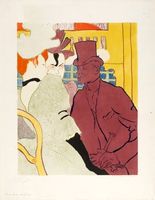 An Englishman at the Moulin Rouge "Henri-Marie-Raymond de Toulouse-Lautrec-Monfa was the son of an aristocratic family of Toulouse. His parents could trace their ancestors all the way to Charlemagne. Since his father and mother were first cousins, their offspring inherited a serious bone disease and stopped growing early. Constantly required to rest, the little boy started drawing and painting. In one of the three windmills left as a memento on the Butte Montmartre, the Paris Moulin Rouge opened in 1889, in the place of a failed drinking establishment. Commercial show-business was already in full swing in Montmartre. Aware of this, the investors in the new venture faced up to the competition with a flood of newspaper articles and posters to reach the middle-class public: they promised sensational shows, masked balls, electric and gas lighting, and had recourse to every standard “everybody who is anybody comes here” trick. Paris by night was also an inexhaustible source of subjects for Toulouse-Lautrec. From the 1890s onwards, he was attracted exclusively by the cabaret and its stars, the circus, and the world of night entertainment. The fin-de-sičcle Paris market and critical acclaim also encouraged him in his choice of themes. The coloured lithograph, An Englishman at the Moulin Rouge displays Lautrec’s exceptional talent for caricature. In an interior of exaggerated lines and plane-like patches of colour, two prostitutes are speaking with a man in a top hat, in a frame close to the viewer. The facial expressions and self-confident postures of the women proclaim their experience on the “hunting grounds”. The artist records this crucial moment of night life with elegant economy: the largest patch of colour is the brown tone of the male figure, which is echoed in the colour of the hat of the woman opposite, just like the yellow of the background bar in the colour of the chair in the foreground. Despite the figures’ close proximity and their static posture, it is as if we are viewing a snapshot of a scene in motion. This illusion is reinforced by Lautrec’s favourite device, cutting off the edges of the picture: the scene seems to continue beyond the field of view." -Text: © ZSUZSANNA GILA, Google Arts and Culture
An Englishman at the Moulin Rouge "Henri-Marie-Raymond de Toulouse-Lautrec-Monfa was the son of an aristocratic family of Toulouse. His parents could trace their ancestors all the way to Charlemagne. Since his father and mother were first cousins, their offspring inherited a serious bone disease and stopped growing early. Constantly required to rest, the little boy started drawing and painting. In one of the three windmills left as a memento on the Butte Montmartre, the Paris Moulin Rouge opened in 1889, in the place of a failed drinking establishment. Commercial show-business was already in full swing in Montmartre. Aware of this, the investors in the new venture faced up to the competition with a flood of newspaper articles and posters to reach the middle-class public: they promised sensational shows, masked balls, electric and gas lighting, and had recourse to every standard “everybody who is anybody comes here” trick. Paris by night was also an inexhaustible source of subjects for Toulouse-Lautrec. From the 1890s onwards, he was attracted exclusively by the cabaret and its stars, the circus, and the world of night entertainment. The fin-de-sičcle Paris market and critical acclaim also encouraged him in his choice of themes. The coloured lithograph, An Englishman at the Moulin Rouge displays Lautrec’s exceptional talent for caricature. In an interior of exaggerated lines and plane-like patches of colour, two prostitutes are speaking with a man in a top hat, in a frame close to the viewer. The facial expressions and self-confident postures of the women proclaim their experience on the “hunting grounds”. The artist records this crucial moment of night life with elegant economy: the largest patch of colour is the brown tone of the male figure, which is echoed in the colour of the hat of the woman opposite, just like the yellow of the background bar in the colour of the chair in the foreground. Despite the figures’ close proximity and their static posture, it is as if we are viewing a snapshot of a scene in motion. This illusion is reinforced by Lautrec’s favourite device, cutting off the edges of the picture: the scene seems to continue beyond the field of view." -Text: © ZSUZSANNA GILA, Google Arts and Culture -
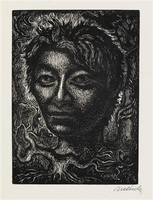 Chiclero Chicle gatherer; face surrounded by roots and foliage. Signed in pencil
Chiclero Chicle gatherer; face surrounded by roots and foliage. Signed in pencil -
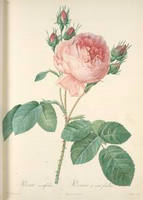 Rosa Centifolia; Rosier de Provence (syn.) Designed by Matteo Florimi, Italian, active Siena, ca. 1581-died 1613, published by Francesco de' Franceschi, Italian, active 16th century, Venice. From top to bottom, and left to right: Design decorated with squares ornamented with an alternating pattern of circles with flowers at the center and diamonds containing different floral motifs.
Rosa Centifolia; Rosier de Provence (syn.) Designed by Matteo Florimi, Italian, active Siena, ca. 1581-died 1613, published by Francesco de' Franceschi, Italian, active 16th century, Venice. From top to bottom, and left to right: Design decorated with squares ornamented with an alternating pattern of circles with flowers at the center and diamonds containing different floral motifs.